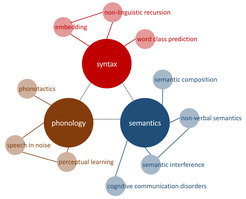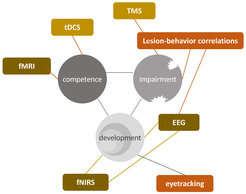Plasticity of Language
Research Focus
The ability to communicate personal needs, emotions and thoughts is central to humans. It implies that language – the most powerful device for human communication – strongly shapes what we know, what we remember and the way we acquire skills. The dark side of such an eminent role for uncompromised intellectual and social functioning is the fact that impairment of linguistic competence is catastrophic for almost every aspect of life. Our group strives to contribute to aspects of how language affords its central role in cognition and cognitive exchange and how people who suffer from language impairment can be supported in (re)acquiring linguistic and communicative skills.
Structure of the group
The group is headed by neurologist (Hellmuth Obrig) and a clinical linguist (Frank Regenbrecht). However, the joint expertise strongly rests on the co-operation with scientists and clinicians from quite diverse backgrounds. Co-operations with Linguists, Psychologists, Speech and Language Therapists and researchers in different fields of neuroscience have and will shape the group. This is an aspect of ‘plasticity’ which we strongly encourage.
Regarding clinical expertise our research is embedded in the clinical work at the Clinic for Cognitive Neurology, University Hospital Leipzig, complemented by a tight link to the national association for Aphasiolgy (www.aphasiegesellschaft.de/).
Our goal to contribute to bridging the gap between theory driven neurolinguistics and clinical research relies on the constitutive cooperation with the Max Planck Institute for Human Cognitive and Brain Sciences. Our group is part of the Institute’s Department of Neurology but research is driven by an equally important input from many a co-operation with the Department of Neuropsychology.
Research projects
Our research questions encompass a broad spectrum. The sketch below illustrates the most parsimonious differentiation of linguistic levels (phonology/ semantics/ syntax), and how research can rely on different groups of participants to address their linguistic and neuronal underpinnings. We are confident that engaging in different projects with studies in neurotypical participants, people with a chronic brain lesion, and in infants will allow for a more comprehensive view of linguistic (dys)function using a wide range of methodologies.
An overview of our research projects will follow soon!

Some of our current and past projects reach beyond the core linguistic functions. The interface between auditory processing and language skills mark one end of such a spectrum. Conversely our interest in cognitive communication disorders (in the absence of overt aphasia) illustrates that language may be special and engages a specialized neuronal network, but cannot be studied without the perspective of a larger overarching cognitive context. Both ‘bottom-up’ an ‘top-down’ interfaces with neighboring fields are mandatory when treating patients with an acquired brain lesion leading to additional perceptual but also more general cognitive impairment.

Methodologies
We apply a wide spectrum of methodologies such as
- Behavioural measures
- fMRI and structural MRI
- EEG
- fNIRS
Our behavioural studies in neuro-typical participants and patients with an acquired lesion in the language network have highlighted the significance of behavioral markers to bridge theoretically motivated work to clinically relevant issues. EEG and fNIRS in combination been one of the foci of the group regarding language development.



